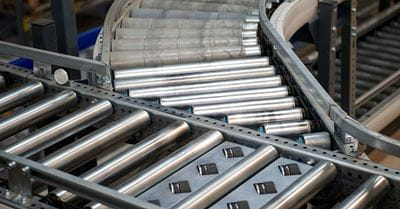Sortation Systems | Los Angeles

Raymond West supplies a full range of conveyor and automation products, including all types of sortation solutions.
To speak with a Raymond automation expert, phone us at 562-944-8067.
Are you considering a sortation solution for your Los Angeles warehouse, distribution center or production facility? The most common kinds of sortation systems vary widely in ability and expense. Below we offer a high level assessment of the benefits and drawbacks of the most popular types of sortation systems.
Cross-Belt Sorter & Tilt Tray Sorter
Tilt-tray and cross-belt sortation systems offer similar functionality and are often associated when talking about sortation mechanization. In reality they are not the same thing at all.
Tilt-tray sorters are made up of trays attached to carts that are transferred on a continuous-loop conveyor. Products are put into the trays at one or more induction stations on the loop via manual or automated procedures. When an item reaches its sorting destination, the tray that is transporting it tilts and dumps the item toward a chute.
Cross-belt sorters are powered belt conveyors added to carts running on a continuous conveyor loop. Comparable to tilt-trays, cross-belt sorters drop materials onto a chute when they reach the right sorting destination.
Advantages: Cross-belt and tilt-tray sorters offer the greatest sorting speed and can manage a wide variety of product types when compared to other sortation systems. They are an excellent choice for operations that manage a variety of SKUs. These kinds of systems are also relatively quiet and enable a more comfortable workplace for warehouse personnel.
Disadvantages: The speed, capacity and flexibility or these sorters come at a price-- they are among the most expensive sortation choices on the market.
Shoe Sorter
Sliding shoe sorters utilize a "shoe" system connected to the conveyor surface that moves and diverts items onto an alternate, after-sort conveyor. Shoe sorter configurations receive goods from a single flow of products that may be a consolidated feed from several upstream locations of a warehouse. These types of sortation solutions are commonly used in shipping applications.
Advantages: Sliding shoe sorter systems allow for a relatively high peak rate, often several hundred products per minute, depending upon the item weight and size. Furthermore, a wide variety of items can be handled because of the simplicity and flexibility of a positive divert approach.
Disadvantages: Shoe sorters are more expensive than other alternatives like pop-up wheel sorters. Likewise, divert areas are not readily movable, making the system complicated and expensive to rearrange. These systems often create more noise than tray or belt equipment and are accordingly not as worker compatible as other kinds of sorters.
Pop-up Wheel Sorter
Pop-up wheel sorters are a popular option due to the fact that they are reasonably inexpensive and easy to deploy. Wheels or rollers are incorporated into a belt conveyor. When a product must be diverted, the wheels pop up to divert items at an angle to an alternate, downstream conveyor.
Advantages: Pop-up wheel sorters are adaptive, so sections can be rapidly incorporated or eliminated when the line needs reconfiguration. These systems can also be considerably less expensive than other sorter types.
Disadvantages: These kinds of sorters deliver quite a bit less performance and capability than tilt-tray, cross-belt or shoe alternatives. They will certainly enhance efficiency, but may not multiply throughput like other alternatives. Due to the fact that pop-up systems don't use a positive divert, the kinds of materials they can manage are limited.
Automated Sortation Systems Near Me
If you'd like more details on sortation alternatives, phone an automation professional at Raymond West today!
Raymond West's Los Angeles facility serves much of Los Angeles County, including Cypress, Santa Fe Springs, Whittier, La Mirada, Downey, Pico Rivera, Los Angeles, Montebello, El Monte, Rosemead, Alhambra, South Gate, Lynwood, Compton, Westmont, Gardena, Torrance, Carson, San Pedro, La Habra, City of Industry, Walnut, Inglewood, Hawthorne and all surrounding areas.
Raymond West | Los Angeles Material Handling Equipment Supplier
5560 Katella Ave
Cypress, CA 90630
(562) 944-8067

